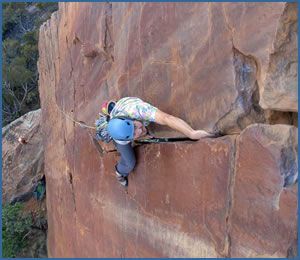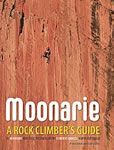Moonarie: A Rock Climber's Guide is the comprehensive guidebook describing the rock climbing at Moonarie and nearby selected crags including Pt Bonney, Devils Peak and Warren Gorge.
Buy this Moonarie rock climbing guidebook from our shop.
Are you a budding travel writer?
Climb Europe are looking for exciting destination articles about various rock climbing areas around the world.
Earn money from your travels by sending your articles to Climb Europe. Contact Us directly.
Moonarie – South Australia’s Trad climbing destination by Rob Baker
Moonarie is one of Australia’s most spectacular crags for rock climbing. Situated on the rim of Wilpena Pound in South Australia’s Flinders Ranges, it has superb rock (quartzite sandstone like Arapiles) and loads of fantastic quality routes. It is South Australia’s premier crag and one of the best in Australia. Moonarie is a true adventure destination, and a worthy stop on the Australian rock climbing tour.
Moonarie is rarely busy. Most weekends you may find only one or two other parties at the crag and sometimes you’ll have it to yourself. Easter and October long weekends are sometimes busy and social but there is no shortage of climbs.
The combination of remoteness, perfect stone, an abundance of soaring lines, huge wedge-tail eagles soaring in the thermals and the dry desert air, make climbing at Moonarie a tough, rewarding and satisfying experience that will draw you back time and time again.

The photograph shows an aerial overview of the right hand side of Moonarie’s upper tiers – Flying Buttress, The Ramparts and The Great Wall sectors.
The rock climbing at Moonarie
Moonarie offers a varied trad climbing experience, with a good range of intermediate to difficult routes. There is very little in the way of sport routes, but the trad climbing is fantastic as the quality of the rock makes it ideal for placing protection. The rock has a similar feel to Arapiles, with the same mixture of natural gear and the occasional bolt. Although there are some easy routes, experienced intermediate and advanced climbers will get the most out of Moonarie. The climbing starts in the low teens and stretches up into the high 20s (Australian Ewbank Grading system). This converts to, F5 to F7c+ (French) or VS to E6 (UK trad climbing scale). The climbing varies from single pitch excursions to long multi-pitch routes that wind their way up to the rim of the Pound.
Moonarie is a wilderness cliff, where the traditional style of placing your own protection applies. On many of the newer routes there is some fixed protection and there are a few fully equipped sport routes to be found. The usual rack of wires and cams/Friends should be carried. Often a few long slings and big nuts will come in handy as will medium to large Hexes or Friends for the older classics like Pagoda, GRRC and Nervine. Most styles of climbing are found at Moonarie, with lots of corners, overhangs, walls and open faces. Many lines follow impressive corner and crack systems. Slab climbing is not well represented. The climbing is often steep and direct: expect to find some sustained sections above protection, which makes the routes engaging and exhilarating! The protection is generally very good. Unlike Arapiles, where there are many excellent routes under grade 12, this grade tends to be the starting point for quality climbing at Moonarie.
The rock is Pound quartzite sandstone, which ranges in colour from yellow to crimson and in texture from fine grained smoothness to coarse roughness. The rock is usually sound and has good friction.
The main cliffs on the rim of the Pound near Top Camp are around 100 -120m high but there are many quality single pitch routes from 10 - 25m on the surrounding crags and walls. These are great for the less adventurous or as a change and different perspective from the multi-pitch routes on the main walls.
One of the most striking features of Moonarie is the famed Great Wall -a spectacular stretch of rich red vertical rock 50 metres high that offers some of the best climbing in the area. The Great Wall is the home of possibly the best 19 in the Australia, Downwind of Angels. Downwind of Angels is only the beginning of the good routes on this wall. There is also Outside Chance (16**), the amazing looking Dry Land (22***), and a host of other starred routes in the low to mid 20s. The Great Wall is only one area of Moonarie. Other parts of the crag such as Checkers Wall, the Ramparts, Flying Buttress and The Great Chimney area are just as spectacular. Moonarie is a crag rich in classics.

The photograph shows Hywell Rowlands on the classic Downwind of Angels, 19 (F6a+ or UK HVS) on the Great Wall of Moonarie.

The photograph shows Duncan Graham on Acid Wall, 24 (F7a or UK E4) on Checkers Wall at Moonarie.
When to visit Moonarie to go rock climbing
The two recommended times of the year to visit for rock climbing at Moonarie, are between March and May, and September to October. The Flinders Ranges is a land of extremes. It can get very hot in summer and cold in winter. There are always sunny and shady areas to climb in so climbing is possible year round. Visiting during the shoulder seasons provides a broader range of options for climbing. Climbing at Moonarie is a rich and incredible climbing experience, well worth the long drive to get there.
What is the best rock climbing guidebook for Monnarie?
The 2019 edition of this new rock climbing guidebook to Moonarie provides information on the best adventures at Moonarie and nearby selected crags including Pt Bonney, Devils Peak and Warren Gorge. This Moonarie climbing guidebook is a full-colour guidebook with photo topos, aerial crag shots and stunning, evocative climbing photos by an array of the top rock climbing photographers in the land. The guidebook is entertainingly written, containing descriptions of the best and most alluring routes - it is a ‘must have’ for all climbers.
Travel and Access
Moonarie is located 450km north of Adelaide in South Australia. The turnoff is about 40km from Hawker on the way to Wilpena. A 4WD is recommended for the last section of road, but usually a 2WD is sufficient. There is also a bus that travels between Adelaide and Wilpena Pound. A 45-minute walk uphill gets you to Top Camp where most of the climbing is accessed. Most people stash gear at Top Camp each night, which reduces the walk to 30 minutes.
Where to Stay
There is a remote campsite at the base of the track up to Moonarie, which is on private land, so it is very important to leave this area in a respectable state and carry out all your rubbish. There is no water so you need to bring your own. There are no toilet facilities so BRING A SHOVEL. If you desire more facilities, it is possible to camp at Wilpena Pound (15km away), Rawnsley Park (15km away) or find accommodation at Hawker, the closest town.
Local Facilities, Attractions and Rest Day activities
Hawker is the closest town, with good amenities, petrol, two mechanics and a small supermarket. The Rawnsley Park caravan and camping ground is 5kms south of the Arkaroo Rock turnoff back towards Hawker and is the closest source of petrol, propane gas, milk, bread etc. Showers can be had here as well. The Wilpena Resort (15kms north of Moonarie) has a bar and bistro with good meals for about $20 each, a small but diverse supermarket, a tourist centre and a shop with liquor licence.
The Wilpena area has many scenic walks, with a hike to St Mary Peak (7-8hrs return) or Edeowie Gorge in the Pound (5-6hrs) being really worthwhile for rest days or diversions. Closer to the campsite, Arkaroo Rock has Aboriginal rock painting, a pleasant half hour walk and will give you a different perspective on the cliffs. Further north, Bunyeroo and Brachina Gorges likewise provide some delightful walking, and, particularly in the latter, the opportunity to see yellow-footed rock wallabies.
Map showing the location of Moonarie rock climbing area in South Australia

Click on the thumbnail images to view a larger photograph of the excellent rock climbing to be found at Moonarie.
Moonarie: A Rock Climber's Guide is the comprehensive guidebook describing the rock climbing at Moonarie and nearby selected crags including Pt Bonney, Devils Peak and Warren Gorge.
Buy this Moonarie rock climbing guidebook from our shop.
Are you a budding travel writer?
Climb Europe are looking for exciting destination articles about various rock climbing areas around the world.
Earn money from your travels by sending your articles to Climb Europe. Contact Us directly.







